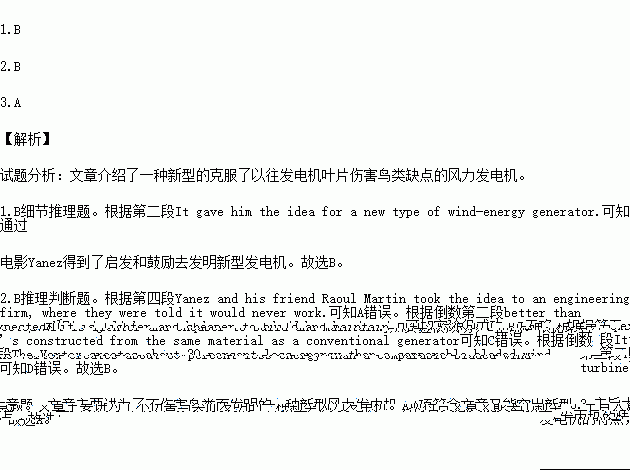题目内容
请认真阅读下列短文,从短文后各题所给的A、B、C、D四个选项中,选出最佳选项,并在答题卡上将该项涂黑。
Wind turbines are efficient sources of cheap energy but also a source of concern as their huge spinning blades (叶片) frequently kill birds and bats. A new type of wind generator developed in Spain offers a creative solution to that problem.
In 2002, Spanish inventor David Yanez saw a short film about the Tacoma Narrows Bridge in the U.S., collapsing in strong wind. It was a vivid example of the powerful vibrations wind can create when it blows past a long pole, such as a car antenna or even a stick of bamboo. It gave him the idea for a new type of wind-energy generator.
“The initial philosophy or spirit was to create a generator of dreams that had all the qualities one would want: It should be as cheap as possible, need as little maintenance as possible, the setup as simple as possible,” he said.
Yanez and his friend Raoul Martin took the idea to an engineering firm, where they were told it would never work. Undiscouraged, they started experimenting on their own in a small wind tunnel they built.
Good initial results were repeated by a larger working model called Vortex (涡旋) installed in a nearby field. “What we have is a mast (桅杆), which is the top piece and acts as a blade,” Yanez said. “It’s constructed from the same material as a conventional generator, and what it does is it oscillates (振荡), transmitting the oscillation to a conventional alternator, which by its own oscillation converts the wind’s energy into electric energy.”
Yanez said the output of the 6-meter-tall generator, and even that of smaller models, was better than expected. The Vortex creates about 30 percent less energy than a comparable bladed wind turbine, but it is lighter and cheaper to build and maintain. It is made mostly of reinforced plastic and has very few moving parts. Also, it does not create noise and—even more important for many environmentalists—it does not present a threat to passing birds.
The current prototype works at wind speeds ranging from 1.5 to 7 meters per second. The inventors say the next step is building a 12.5-meter tall bladeless generator with a 4-kilowatt capacity that could power small businesses or individual homes, or provide supplemental power to a main grid. The commercial version of the Vortex Bladeless generator should be ready for the market by 2017.
1.The author mentions a short film about the Tacoma Narrows Bridge to show ________.
A. what the initial philosophy or spirit was
B. what inspired Yanez to create the generator
C. how the bridge was destroyed in strong wind
D. how wind creates powerful vibrations
2.What do we know from the passage?
A. The original idea was considered as practical in an engineering firm.
B. Yanez and Martin’s initial tests by themselves proved to be successful.
C. The material for constructing the mast is different from that of the past.
D. The new generator is better at creating energy than a comparable bladed one.
3. What would be the best title for the passage?
A. Bladeless wind-power generator is friendly to birds.
B. Wind turbines are efficient sources of cheap energy.
C. A new generator will come onto the market by 2017.
D. Yanez has made a generator for the benefit of people.
 阅读快车系列答案
阅读快车系列答案阅读下列短文,从每题所给的四个选项(A、B、C和D)中,选出最佳选项。
Revolutionary TV Ears
TV Ears has helped thousands of people with various degrees of hearing loss hear the television clearly without turning up the volume(音量) and now it’s better and more affordable than ever! With TV Ears wireless technology, you set your own headset volume, while other TV listeners hear the television at a volume level that’s comfortable for them. You can even listen through the headset only and put the TV on
mute(静音)if the situation calls for a quiet environment —maybe the baby is sleeping. Or perhaps you are the only one who is interested in listening to the ballgame.
TV Ears patented technology includes a revolutionary noise reduction ear tip, not used in any other commercially available headset. This tip reduces outside noise so that television dialogue is clear and understandable. Get the technology that has proven to help the most demanding customers. That’s why TV Ears has earned the trust and confidence of audiologists(听觉学家) nationwide as well as world-famous doctors.
Doctor Recommended TV Ears! “My wife and I have used TV Ears almost daily for the past two years and find them a great help in our enjoyment of television . As a retired ear doctor, I heartily recommend TV Ears to people with normal hearing as well as those with hearing loss.” — Robert Forbes, M. D, CA |
Customer Recommended TV Ears! “ Now my husband can have the volume as loud as he needs and I can have the TV at my hearing level. TV Ears is so comfortable that Jack forgets he has them — Darlene & Jack B, CA |
Risk Free Trial! TV Ears comes with a 30-day risk free trial.
Special Offer — Now $59.95.
If you’re not satisfied, return it.
Money-back guarantee!
Call now ! 800-123-7832

1.TV Ears helps you ______.
A. improve your sleeping quality
B. listen to TV without disturbing others
C. change TV channels without difficulty
D. become interested in ballgame programs
2.What makes TV Ears different from other headsets?
A. It can easily set TV on mute
B. Its headset volume is adjustable
C. It has a new noise reduction ear tip
D. It applies special wireless technology
3.This advertisement is made more believable by ______.
A. using recommendations
B. offering reasons for this invention
C. providing statistics
D. showing the results of experiments


 on ! He can once again hear and understand the dialogue.”
on ! He can once again hear and understand the dialogue.”